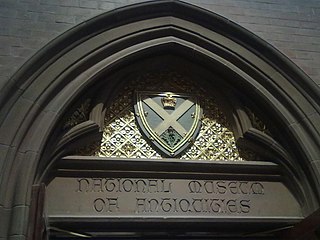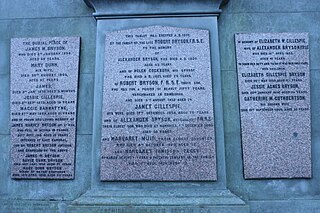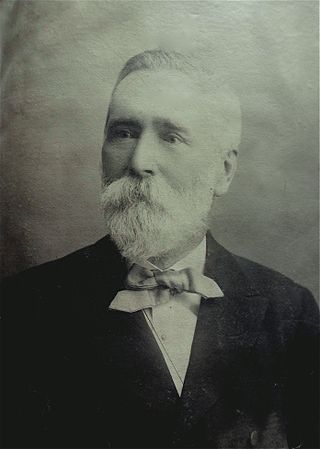Related Research Articles

The Dean Cemetery is a historically important Victorian cemetery north of the Dean Village, west of Edinburgh city centre, in Scotland. It lies between Queensferry Road and the Water of Leith, bounded on its east side by Dean Path and on its west by the Dean Gallery. A 20th-century extension lies detached from the main cemetery to the north of Ravelston Terrace. The main cemetery is accessible through the main gate on its east side, through a "grace and favour" access door from the grounds of Dean Gallery and from Ravelston Terrace. The modern extension is only accessible at the junction of Dean Path and Queensferry Road.

Sir Henry Raeburn was a Scottish portrait painter. He served as Portrait Painter to King George IV in Scotland.

Major General Sir Thomas Makdougall Brisbane, 1st Baronet,, was a British Army officer, administrator, and astronomer. Upon the recommendation of the Duke of Wellington, with whom he had served, he was appointed governor of New South Wales from 1821 to 1825.

The Society of Antiquaries of Scotland is the senior antiquarian body of Scotland, with its headquarters in the National Museum of Scotland, Chambers Street, Edinburgh. The Society's aim is to promote the cultural heritage of Scotland.

The Royal Society of Edinburgh (RSE) is Scotland's national academy of science and letters. It is a registered charity that operates on a wholly independent and non-partisan basis and provides public benefit throughout Scotland. It was established in 1783. As of 2021, there are around 1,800 Fellows.
The Bannatyne Club, named in honour of George Bannatyne and his famous anthology of Scots literature the Bannatyne Manuscript, was a text publication society founded by Sir Walter Scott to print rare works of Scottish interest, whether in history, poetry, or general literature. The club was established in 1823 and printed 116 volumes before being dissolved in 1861.

Daniel Stewart's College was designed by the architect David Rhind and opened as Daniel Stewart's Hospital in 1848, renamed to Daniel Stewart's College in 1870, and placed under the perpetual management of the Royal Company of Merchants of the City of Edinburgh.

The Grange is an affluent suburb of Edinburgh, just south of the city centre, with Morningside and Greenhill to the west, Newington to the east, The Meadows park and Marchmont to the north, and Blackford Hill to the south. It is a conservation area characterised by large early Victorian stone-built villas and mansions, often with very large gardens. The Grange was built mainly between 1830 and 1890, and the area represented the idealisation of country living within an urban setting.

George Wilson PRSSA FRSE was a 19th-century Scottish chemist and author. He was Regius Professor of Technology at the University of Edinburgh, and the first Director of the Industrial Museum of Scotland.

Greyfriars Kirkyard is the graveyard surrounding Greyfriars Kirk in Edinburgh, Scotland. It is located at the southern edge of the Old Town, adjacent to George Heriot's School. Burials have been taking place since the late 16th century, and a number of notable Edinburgh residents are interred at Greyfriars. The Kirkyard is operated by City of Edinburgh Council in liaison with a charitable trust, which is linked to but separate from the church. The Kirkyard and its monuments are protected as a category A listed building.

The Munros of Auchinbowie are a distinguished branch of the Scottish, highland Clan Munro. From this family three Professors of Anatomy at the University of Edinburgh, Scotland were produced, as well as several other doctors and military officers.

Alexander BrysonFRSE FGS FRSSA FSAScot FRPSE was a Scottish biologist, geologist and horologist who served as president of the Royal Scottish Society of Arts (1860–61) and as president of the Royal Physical Society of Edinburgh (1863).

New Calton Burial Ground is a burial ground in Edinburgh. It was built as an overspill and functional replacement to Old Calton Burial Ground and lies half a mile to its east on Regent Road in Edinburgh, Scotland, on the south-east slopes of Calton Hill. On its southern edge it attaches to the north-east edge of the Canongate in the Old Town. It lies on a fairly steep south-facing slope with views to Holyrood Palace, the Scottish Parliament Building and Arthur’s Seat.
The Royal Physical Society of Edinburgh was a learned society based in Edinburgh, Scotland "for the cultivation of the physical sciences".

Stevenson Macadam was a Scottish scientist, analytical chemist, lecturer, and academic author.
References
- ↑ "Past Presidents". Royal Scottish Society of Arts. Retrieved 3 April 2017.
- ↑ Encyclopaedia Britannica: 11th Edition.
- ↑ "Story: Beverly, Arthur". Te Ara. Retrieved 3 April 2017.
- ↑ "'Harnessing the winds': Professor James Blyth, pioneer of renewable energy". stratharchives. Retrieved 2 May 2018.
- ↑ "Sir Thomas Brisbane Special". Australasian Planetarium Society. 10 April 2016. Retrieved 24 July 2018.
- ↑ "Royal Scottish Society of the Arts". Heraldry of the World. Retrieved 11 September 2021.